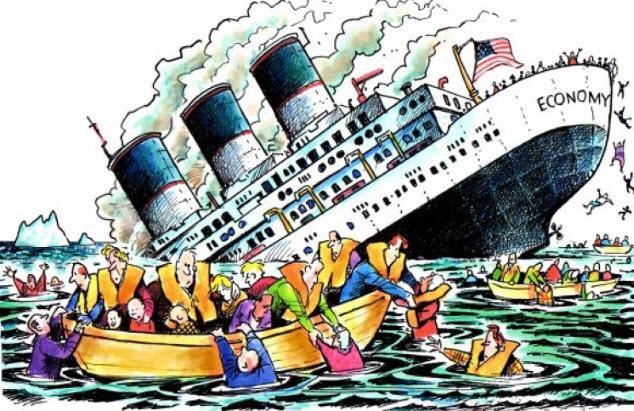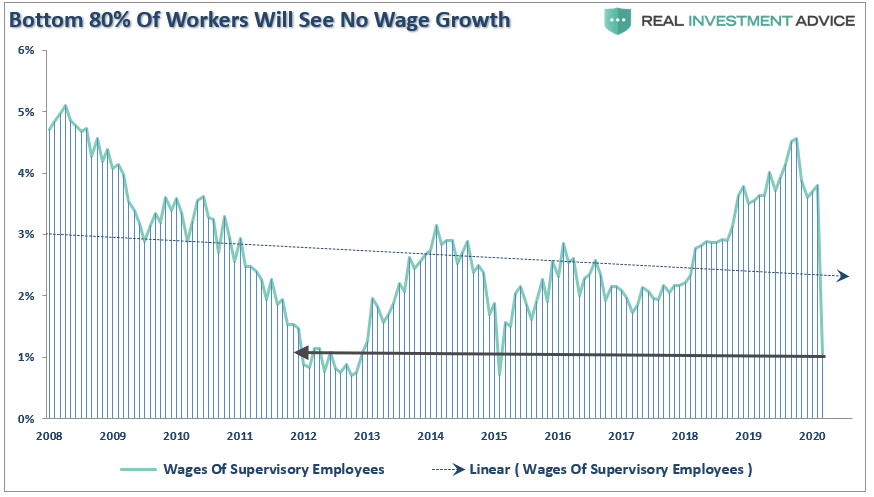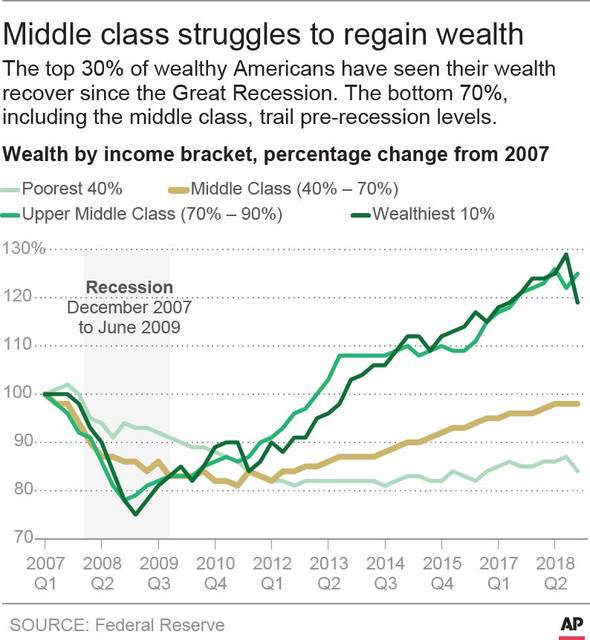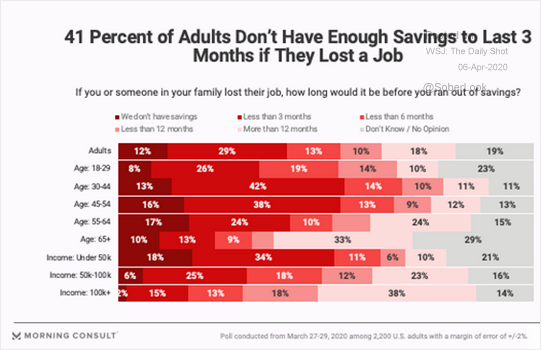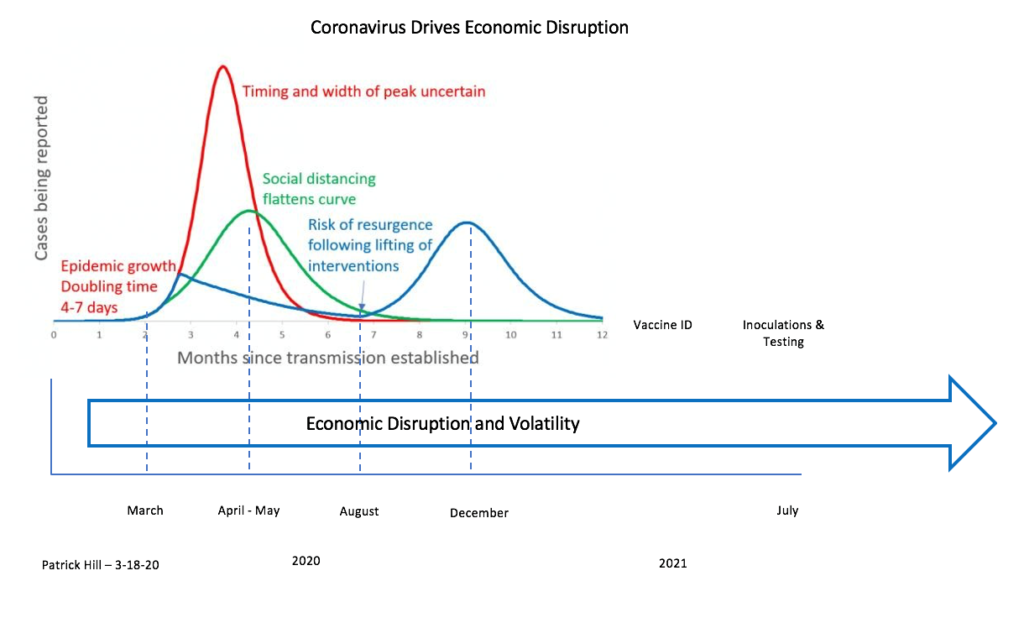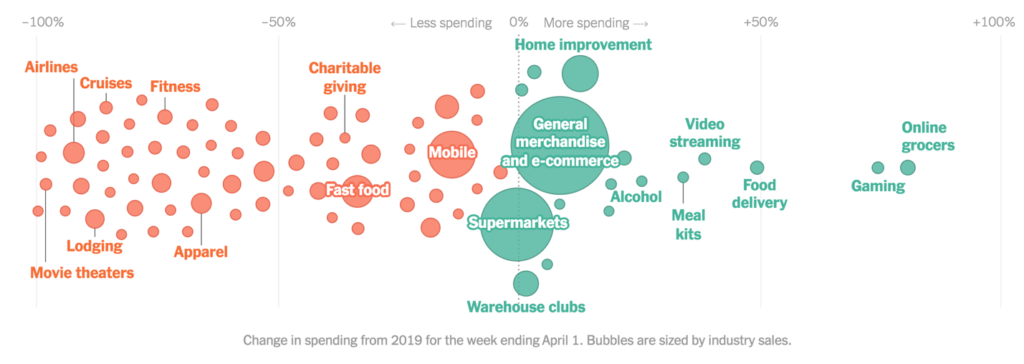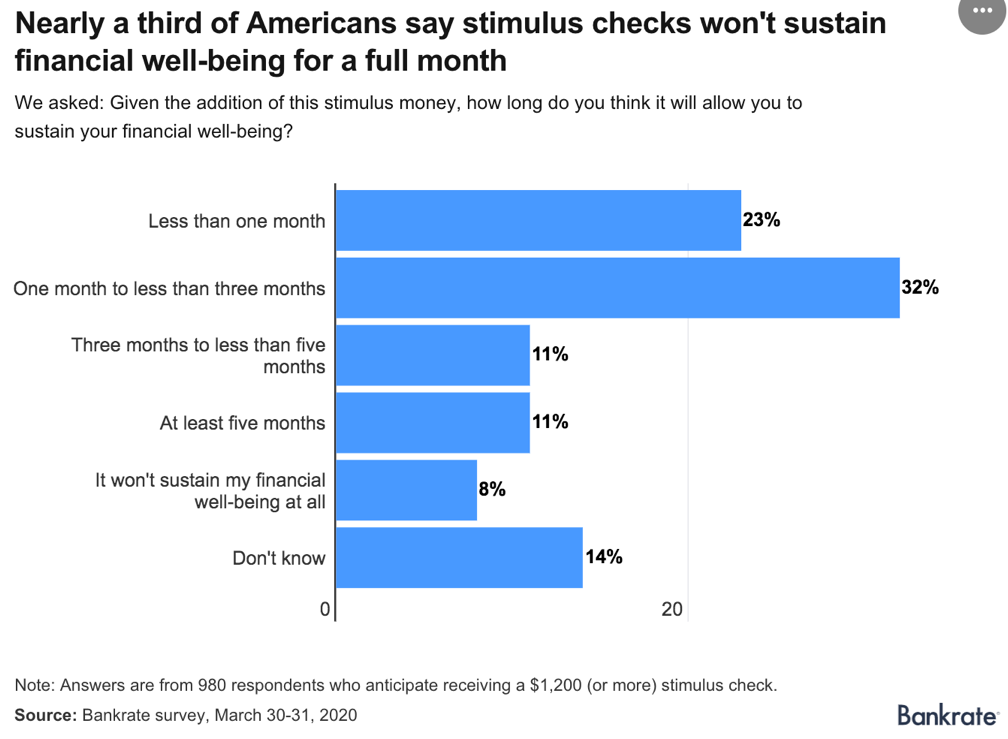The “Unsinkable” US Economy Strikes A Pandemic Iceberg – The Map Ahead
Authored by Patrick Hill via RealInvestmentAdvice.com,
The ‘unsinkable’ Titanic was designed to withstand a breach of four compartments, ensuring the ship would stay afloat. On the evening of April 14, 1912, the ship hit an iceberg, breaching five compartments, and within two and half hours, the vessel sank. Many investors think the U.S. economy, like the Titanic, is unsinkable as well. Yet, we have discovered the economy can sink when the most vulnerable sector of our economy is hit – the consumer. The country has been severely damaged by a pandemic iceberg aimed right at the consumer. Never in the history of our country have we shut down 25% of economic output in a few weeks. In just three short weeks, millions of people are out of work or furloughed with millions more to come. Goldman Sachs expects an unemployment rate of 16% or higher, levels not seen since the Great Depression. The Michigan Survey of Consumer Sentiment dropped to 71.0 for April from March’s 89.1, the largest drop on record. Consumers are sheltering in place, not going to work, or buying at stores, causing spending to drop precipitously as concerns about job security soar.
How did consumers become so vulnerable to a loss of income, job security, and standard of living? It started at least eleven years ago. During the Great Recession, corporations and banks received federal bailout dollars close to $900 billion to help move bad loans off their books, shift mortgages to the Fed, and make low-interest loans available to companies. Consumers received no relief for the reduction of the value of their homes, triggering millions of foreclosures, with 50% or more losses to savings and retirement plans. Millions of homeowners lost significant amounts of equity in their homes. Household wealth declined by $16.4 trillion dollars at the trough of the Great Recession in 2009. Corporations and the wealthy who owned corporate stocks were bailed out and consumers were not made whole. Thus, the working class started the eleven year economic recovery in a weak financial position.
Since 2009 the working class has not enjoyed the fruits of a growing economy the way the top 1% has benefited. Wages for the bottom 80% have stagnated over the past eleven years.
Source: RIA, 4/2/20
Those people in the bottom 70% have been left out of the increase in wealth as well, while most of the asset creation has gone to the top 30%.
Source: Federal Reserve – 7/2018
Due to a lack of income and wealth creation, many consumers turned to credit cards to sustain their standard of living. Sales for trucks and SUVs soared in 2019, saddling consumers with long term auto loans, some with ‘negative equity’ from a previous unpaid loan rolled into the new loan for more extended periods of time. Auto loan delinquencies had been increasing prior to the present pandemic.
Do consumers have at least some savings to fall back on in the event of a financial emergency? No. A survey of adults found that 41% of workers would only have enough savings to make payments for three months if they lost their job.
Source: Morning Consult, The Wall Street Journal, The Daily Shot – 4/6/20
Six weeks ago, the COVID -19 pandemic arrived in the U.S. The experts told policymakers the only way to contain the infection rate, and resulting deaths was to deploy social distancing programs forcing the closure of most businesses except for essential services. Epicenter states like California and Washington quickly called for ‘shelter in place’ programs. The virus began to strike significant population centers like New York City and Detroit. Unemployment reports show 16.7 million workers were either furloughed or unemployed just in the last three weeks. There are many more uncounted unemployed as some workers have given up trying to apply for assistance on congested websites, and others have not yet applied. The weekly claims number will continue to rise in the weeks ahead.
Dr. Anthony Fauci, the lead epidemiologist of the White House pandemic committee, has announced that the U.S. infection peak may be in sight. Inflection rates have begun to fall in some big cities, so the flattened curve may be in place by May. However, six states have not imposed lock downs opening a considerable risk of a major infection wave. Reports from California are encouraging as experts forecast, at present rates, not all corona virus hospital beds will be needed. California Governor Newsom expects a peak in May. However, he does not expect to end the shelter-in-place policy for some months.
The following diagram shows how the first peak wave in April – May resulted in a flattened curve as a result of social distancing. The National Academy of Sciences released a report sent to the White House recommending social distancing programs be kept in place longer than planned because of a high probability of a second wave of infection. The second wave is likely to peak in the winter of 2020. Researchers are working to develop an antibody test to see if people have been exposed and recovered from the virus, which will clear them for social activity. A vaccine is being tested on humans today but is at least 14 – 18 months away from general distribution. Los Alamos Labs released a report recommending that due to the rapid speed of the infection a combined vaccine and antibody testing program will require the participation of 83% of the population to contain the virus finally.
Sources: FIPhysician – Patrick Hill – 4/8/20
When will people return to work on a large scale? Most people will be reluctant to return to stores or work until they are vaccinated or otherwise assured that others are not contagious. When can we expect all workers to return to work? Health authorities are planning to clear workers in essential industries already traveling to the office or plant. Next, other workers will need to be cleared for work by taking an antibody test to show if they have had the virus and have recovered or they have been vaccinated. All of these virus programs need to be deployed on a national scale for millions to be tested or vaccinated. Based on the present chaotic handling of pandemic logistics, we think testing and vaccination programs will take a long time to reach 83% of the population.
Experts predict the earliest date for a preventative rollout is July of 2021. The delay in a rollout will mean a slow, steady rise of limited economic activity into 4th Quarter 2021. Due to the economic damage from social distancing forcing many businesses to close and high unemployment, consumer spending will be capped. Reduced consumer spending will be a huge drag on economic recovery. In the meantime, the economy will fall into a deep recession from the massive unemployment levels. Corporations are trying to survive debt payments or find loans, and small businesses are caught in a bureaucracy to get crucial SBA loans. During the next 18 months, the markets will be highly volatile, responding to rumors, ideas, and policies that have yet to be funded or implemented. Even those programs which are funded are riddled in bureaucracy and not able to live up to their objectives.
Consumers are in shock at the speed of their job losses and financial security. Many will probably suffer a kind of pandemic induced Post-Traumatic Stress Disorder (PTSD) that will take months if not years to recover from fully. While many workers went to homes that were safe, others went back to homes that were abusive or situations of high stress with children. There may be workers who, as a result of the trauma of social distancing, may not be able to return to work.
Corporations will learn from the huge ‘work from home’ experiment how to use workers remotely, reduce the number of workers to get a job done, and as a result, likely will install automation software. It is unlikely that job creation will return to pre-pandemic levels any time soon.
After an 18 month recovery from the pandemic, Great Depression level economic consequences are likely to take much longer to fix. The virus has unveiled a weak economy, particularly for the middle class. The pandemic has triggered a set of downward falling financial and credit market dominoes.
Prior to the pandemic, corporations had the highest debt level to GDP in the last 20 years. Companies spent over $1 trillion in stock buybacks in 2019, missing the opportunity to invest in new product development, increase wages, increase productivity, or save the money for an unexpected event. Unemployment is soaring, businesses have huge debt expense overhead, consumers are burdened with student loan, credit card, and auto debt, limiting a full economic recovery.
Productivity is at new 30 year lows, requiring investments in productivity enhanced systems and services to allow companies to become profitable again. Small businesses, accounting for 60% of all employment, are facing tight budgets, with most only having enough funding to stay in business for a month or two months before shutting down. Federal Reserve liquidity programs fueled market speculation to historic heights driving stock market valuations to levels not seen since 2000. Ned Davis Research notes that market valuations are at least 20% overvalued by stock buybacks alone.
A Map Ahead
Congress has passed an aggressive set of pandemic bills to bail out the airlines, provide sick leave to workers, small business loans, and immediate $1,200 checks to adults. The collection of bills totaling a record $3.1 trillion in aid will result in providing a cushion for many workers and businesses for at least the first wave of the virus infections into this summer. States and city governments are to receive $400 billion in support funding. They provide 8.5% of GDP, so funding their operations is crucial to the economy. Our country will have millions of workers dependent on checks from the government, increasing federal budget deficits while corporations will be reluctant to hire employees back until demand returns.
More rescue funds totaling $250 billion are already being discussed in Congress to help small businesses. Small businesses report major problems in obtaining SBA loans due to terrorist and money laundering audits delaying approvals for funding as much as 30 days. Fifty percent of all small businesses have less than one month of cash buffer days. Many small businesses may be forced to shut down their business due to these delays. The Federal Reserve has just announced $2.3 trillion for small and medium businesses and to buy corporate bonds including corporate junk-rated bonds. For small businesses that can hang on, this new Fed funding will help but only if they can access the funds in time. Already, some restaurant businesses are shutting their doors for good after losing 90% of their revenue in the last month, and not seeing a profitable opportunity in running a delivery-only service.
The most critical factor in getting the economy growing again is consumer spending, which drives 70% of GDP. For the week ending April 1st the following chart shows credit card and debit card spending compared to the same week in 2019. Many sectors experienced almost a complete stop in spending while grocery, e-commerce, video conferencing, and food delivery spending surged.
Sources: Ernst Research, New York Times – 4/11/20
So, how is consumer demand likely to build in a recessionary environment? Here is a list of types of workers that will be employed and provide emerging demand:
-
Knowledge workers will be the first consumers to feel comfortable spending as they are already receiving regular paychecks while working from home. These workers are in Internet services, software, telecom, office jobs in e-Commerce, or financial services. They will be comfortable increasing spending early in the economic cycle.
-
Healthcare workers are in demand as healthcare providers will need to see patients on a returning basis, yet have discovered how to perform telemedicine appointments for simple diagnosis and treatment. The healthcare worker group would include doctors, nurses, technicians, and office staff. Home nurses will likely be needed as well as the population continues to age or for recovery of COVID – 19 patients. Companies that specialize in telemedicine services, employing software engineers and health care technicians will likely see their business continue as cost cutting by health care providers will make lower cost telemedicine a more cost effective alternative to office visits. Drug company workers such as scientists, biochemists, biostatisticians will be in demand as researchers look for treatment medications, testing, and vaccine alternatives. Drug store workers such as pharmacists and retail clerks will be in demand to keep drug stores open. Mask, ventilator, and medical supply company workers will see firm demand for their skills as well.
-
City emergency services workers including police, firefighters, communications workers, and other community support services staff will be kept on by cities even with tight budgets. State government workers in similar roles will be in demand as well. Tax revenues are already forcing state and local governments to layoff non-essential workers.
-
Grocery store clerks, managers, cashiers and butchers will be needed. Food processors such as meat, chicken, and turkey packers will be working to hold onto staff. Food suppliers, including farmers, dairy farm managers, farmworkers, and ranchers, are required to provide food products. Food wholesalers run by managers, and logistics staff and truckers bringing the food to grocery stores will continue to be working
-
Warehouse, fulfillment, and expediting workers will see job growth as many traditional retailers do not survive, leaving fewer alternatives for many consumers but to purchase merchandise online. Amazon and Walmart plan on hiring hundreds of thousands of workers in warehousing, fulfillment, and expediting. Workers in traditional retail will continue to see job prospects dim. Many mall landlords report up to 50% of their tenants are not paying their rent for April. If the reduction in consumer spending continues for a year, it is likely that most of these mall stores will close, and many mall districts close down. Malls often use major department stores as anchor stores to bring in consumers and create floor traffic for smaller mall tenants. Now, with department stores under siege like Macy’s, JC Penny, Kohls, and others, malls will lose their customer base.
-
Owners and workers at small businesses that will be successful in obtaining government loans, and survived limited sales for 18 months will be critical to the economy Those companies that are inventive during the lockdown will likely come out of the gate first. For example, one enterprising barber set up a ‘virtual hair cutting business’ over the Internet. She sets up a Zoom session with the client, she cuts a wig on a mannequin and then supervises the cutting of a proxy cutter on her client. Grocery stores are offering ‘senior hours’ when doors open for seniors to do shopping right after the store has been disinfected. Fabric stores are offering mask kits or willing to make masks and sell them for just their labor cost. Owners that shift their business to demand created by the crisis and do so in a supportive manner will likely fare well. Restaurants are running special ‘curb’ delivery options for patrons to call in or order over the Internet, then pick up their order at the curb. The patron stays in their car, and they receive the food all boxed up, sign the credit card receipt and drive off with the meal.
Manufacturing in the U.S. was already in economic contraction before the pandemic from tariffs and slowing global demand. Manufacturers will be slow to rehire production workers. These workers will be last to come back to work as they need setup time for plant equipment, establishing new rules for safety and disinfecting their workplace. The key issue will be how soon market demand will come back for their products to make manufacturing runs profitable.
Teachers have been working online as most K – 12 districts have closed schools. The districts look to open in the fall, yet tax revenues are likely to decline, and schools may need to cut back on staffing. Higher education institutions with strong demand for admissions will likely weather the crisis well, particularly if they have well-funded endowments. Smaller colleges dependent on campus face to face learning may be challenged in bringing students back to school.
The last workers to begin consuming in a major way are those who were most vulnerable during the pandemic in travel, airline, hotel, restaurant, or related services. These hourly workers, with little savings, living on unemployment checks will try to ‘hold on’ until hiring resumes. Upper middle-class consumers and visitors from other countries should start to travel when the ‘pandemic’ is clear. Still, it will take time for travelers to become comfortable again in their safety.
Will the $1,200 checks jump-start the economy? No. A Bankrate survey found that nearly a third of people said the check would sustain financial well-being about a month:
Source: Bankrate – 3/30/20
Over the next 18 months, Americans are likely to see steep declines in employment and income. Financial markets will be volatile based on rumors and news headlines about the virus as well as the coming Presidential election. The election will not end the economic uncertainty as federal deficits to pay for a continuing series of bailouts and stimulus packages will put extreme pressure on the Federal Reserve, credit, debt, and stock markets. After the virus situation stabilizes, the economy can begin to grow. But, the financial damage to household income and wealth will be worse than the Great Recession. Consumer demand based on workers returning to their offices, factories, and restaurants will be uneven, difficult to predict, and slow in returning. We expect the economy to go through a dramatic transformation as whole sectors shift to meet demand, or decline replaced by new major consumer and services industries.
We need to look to ourselves to solve pandemic induced economic problems. The excesses of the past that have created the highest level of wealth and income inequality since 1929, and have not worked to build and economy that works for all Americans. The Federal Reserve has created no moral hazard for executives to speculate in stocks by buying junk corporate bonds. Executives allocated profits and used more debt to goose the price of their company stock and increase their wealth. Trillions of dollars that could have been spent on increasing productivity, raising wages for workers, and innovation were wasted. Speculation, debt, and short term focus on wealth building for the 1% put consumers in a vulnerable economic position.
We must return to the values that built an economy that works for all. Labor needs to have equal economic power with capital. Corporate decisions must be made based on responsibility to all the people from a long term perspective. The pandemic has made the lack of a labor safety net manifest to everyone. Americans, under capitalism, built the most innovative, self-renewing, wealth building economy in the world. It is the American spirit of entrepreneurship combined with invention, self-sacrifice, equal opportunity, and creativity that will build the businesses of the future. These new businesses will adjust to new social realities and pave the way for workers to gain job security and become confident enough to spend at robust levels.
Tyler Durden
Thu, 04/16/2020 – 12:55
